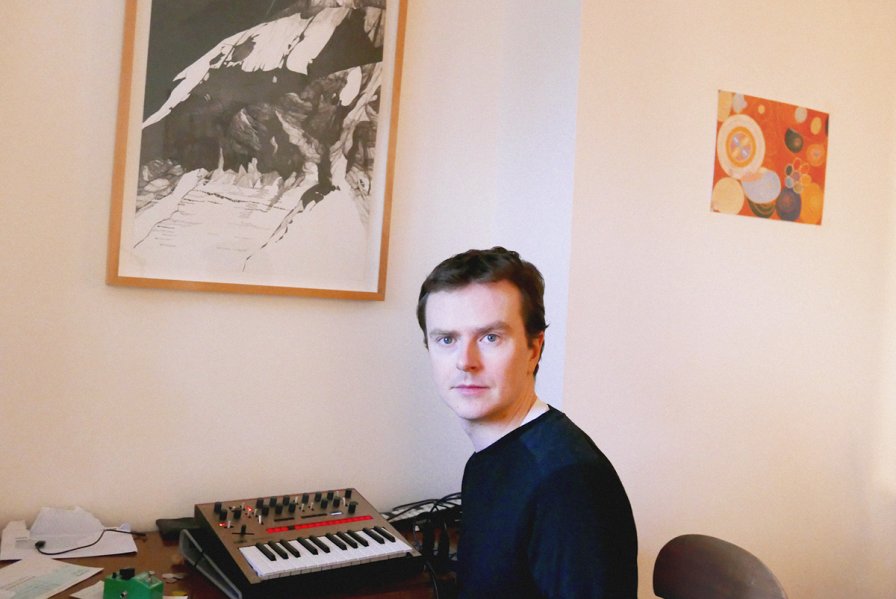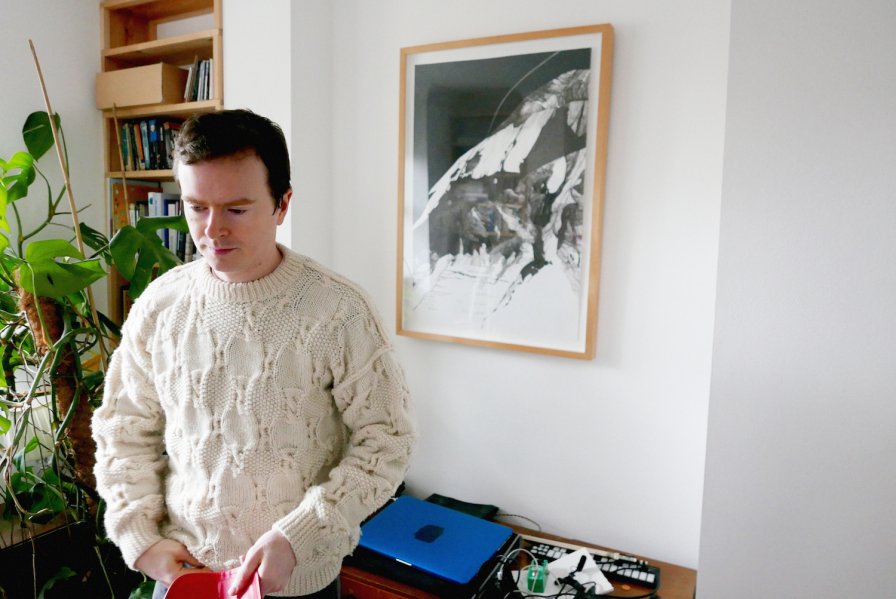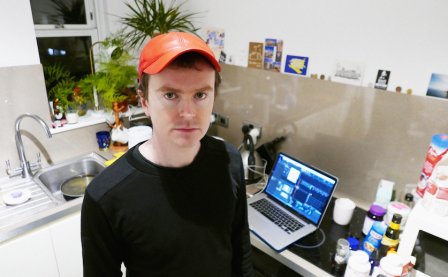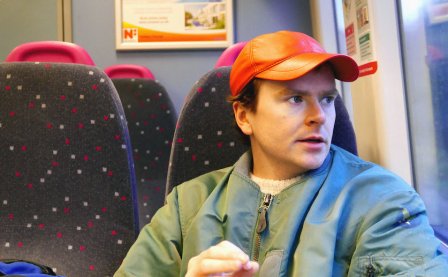Composer, producer, and cellist Oliver Coates recently released Shelley’s on Zenn-La, his third solo full-length and first on RVNG Intl. The album relies on a peculiar splicing of IDM, distilled pop, and faint folk that manifests a multicolored, amaranthine microcosm. Located on the fictional planet Zenn-La, it is home to an apocryphal amalgam of Shelley’s Laserdome, the fabled Stoke-on-Trent nightclub from the late 80s/early 90s, and a futuristic dance floor whose inhabitants are possessed by a perpetual, time-displaced dance to the sounds of early rave, electronica, and minimalism.
Shelley’s on Zenn-La is both a synthesis of previous works and a departure in Coates’s diverse and fruitful career, his projects and collaborations almost too many to mention. In the realm of classical music, he is the primary cellist for the London Contemporary Orchestra and has worked with the likes of Laurie Spiegel and John Luther Adams. Outside of it, he has collaborated with Mica Levi on 2016 album Remain Calm and with Laurie Tompkins on 2018’s Ample Profanity; contributed to Radiohead, Laurel Halo, and Mark Fell records; and performed with Steve Reich, Terry Riley, Dean Blunt, Actress, and Genesis P-Orridge. He has also participated in the making of several film scores, including those for the masterful Under the Skin with Mica Levi and The Master and Phantom Thread with Jonny Greenwood.
But on Shelley’s on Zenn-La, Coates is alone, acting as both a playful tinkerer and a studious composer. Coates builds the record’s song structures by challenging himself, looking for noises that sound gorgeous and meticulously incorporating curious segments into wider narratives. Tinkling FM synthesis and drum sequences composed in Renoise are contrasted and augmented by processed and transformed cello lines. Here, his trademark cello becomes another source of samples, equipotent with all other effects he employs. In a way, Coates creates his own all-encompassing instrumentarium of sounds, as idiosyncratic as the fictional world he explores and one that is only occasionally visited by Kathryn Williams’s enveloping flute, Chrysanthemum Bear’s ethereal vocal lines, and Malibu’s spoken word.
We caught up with Coates to talk about Shelley’s on Zenn-La, among other things.
Shelley’s on Zenn-La emanates a warm and welcoming feeling, a certain sense of optimism.
Thanks! At the mastering stage, I asked for it not to be squeezed like commercial electronic music, so that we might preserve the internal dynamic balances as much as possible. I think coldness perceived in electronic music may partly be connected to listening fatigue, where pounding transients are all peaking at the same level and eliminate dynamic relationships between instrument groupings. I’m anti music feeling as if everything is brick wall limited. I don’t need the kick drum to shake anything. It connects back to the music: I have this background playing Bach cello suites where some of the best bass notes are imagined or implied rather than heard because there’s not so much scope for polyphony on a monophonic instrument. I sometimes like skeletal textures, where the listener is coaxed into imagining parts of the music image. More room for fantasy that way.
The album and its title evoke a sort of British retrofuturism. It sounds bittersweet and melancholy, but ultimately optimistic. Like something that Sun Ra would have made had he been clubbing and raving in the late 80s and early 90s. Were you guided by a concept while working on the record?
There was no concept, just having fun making tracks for RVNG. Towards the end, that title came to me. The tracks were describing the environment of this impossible space. I edited the album down into something tighter against that image, depicting a series of buildings, public pleasure activities like in Brave New World, and the topography of the outlying countryside and nature.
The music also seems to be a personal reflection, a soundtrack devoted to certain places, London chiefly. Is this something you’ve consciously tried to achieve — using the music to capture and channel subjective impressions of certain areas, neighborhoods, and cities? Is it at all nostalgic?
Perhaps. London is not that important to me culturally. It’s fun to be with your friends or singing in a choir or something. I see failure and friction and busy-ness for its own sake. The terror of being still. I wasn’t consciously describing anything when I was coming up with the music, more listening and seeing what happens.
Has your work with Lawrence Lek, which must have been impressionistic on some level, provided you with any guidance while constructing Shelley’s?
I think Lawrence and I have always shared a similar fondness for the adoption of real spaces and transforming them into fantasy.
In that context, does any of the day-to-day sociopolitical stuff seep into your work?
Making a music LP, I hope to constitute an experience more than a takeaway message. My nature seems averse to tribal or ideological thinking. I’m more interested in friendship and family and effecting change through relationships. More interested in chatting about Beckett than Br_x_t.
Shelley’s often reminds me of a contemporary (re)interpretation of the IDM/techno/dance scenes of the late 80s/early 90s. Were you chasing that particular sound?
Nah, none of that first part rings true. I wasn’t reinterpreting or interpreting anything. I was guided by pleasure, which sounds a bit dodgy, but also giving myself mini-technical challenges such as two simultaneous bass lines (“A Church”), two imaginary drummers in different acoustics going crazy to one click track (“Cello Renoise”), wonky scales, and fake Gaelic folk music (“Charlev”).
The album has a very distinct flow that feels quite deliberate. Yet, given some of your previous work, I can’t help but wonder whether any of its parts were improvised?
Improvising is there, for sure. I have just enjoyed this twix bar a great deal. On this release, I edited it quite heavily. The residual ghosts of improvisation are sometimes what fascinate you; they somehow have higher authority over your conscious self. I might edit over and over, then go back 10 stages to find a set of performance actions you made when you weren’t remotely aware of what you were doing or what the shape was going to be — these always seem to be more compelling. Many of the tracks were much longer, and I was heading for double-album territory. I had a good chat with Matt [from RVNG] and decided to cut it into a manageable form. Eight hours of ambient cello patterns bouncing around in Pure Data can come later.
Do you prefer working within improvised contexts like Remain Calm with Mica Levi or fully composed and premeditated?
Changes all the time. I feel comfortable with certain people around, being in a room with certain people gives me a good amount of ideas that seem fresh. Sometimes I like the hard and fast decisions that have gone into composition, because they’ve been made painstakingly.
Looking at your solo releases, there appears to be a progression in your approach to the cello. You use its unaltered sound on Towards the Blessed Islands and subvert it to produce unexpected sounds on Upstepping, while on Shelley’s you rely more on sound synthesis and electronic effects with the cello pushed back.
That first solo record is an album of performances of music written by other people (David F/Hennessy, Laurence Crane, Larry Goves, Max de Wardener, Iannis X). I think the answer to this question lies in live performances that are centered around live cello performance. I play a New Age melodic sound with ambient synths, Romantic cello lines juxtaposed with aspects of digital music which I trigger and manipulate with my foot controller. I hope I can make more music for records in the future that is actually closer to my live stuff and more about nuanced live cello playing and computer music juxtaposed.

In that sense, “Prairie” is somewhat of an outlier, with the cello its sole actor. Is there some kind of story behind this specific joyful cut?
Years ago, I was approached to make music for an app about the Apollo 11 moon landings. The project got shelved, and I was left with some music I really liked, so I used this one. It was what this record needed.
With your focus shifting to electronic music, do you still enjoy the performative aspects of interpreting someone else’s work as a cellist?
Yes. Working with Larry Goves, Alexia Sloane, Laurel Halo — there are so many good composers out there.
Has your background in classical music influenced your musical journey outside that specific realm?
Realms, moving outside, journeys; I like all these connotations of physical play set against music. Classical Music functions a bit more like an industry. I don’t think it’s a type of music, for sure. There’s 800 years of notated music. I turn up on time because of my background in orchestral structures.
As both a performer within LCO and someone who creates music using computers, how do these two aspects of your art relate?
They both feel like second nature. My relationship with LCO has never been formalized; it’s nice and chill. Editing sound on the computer is about taste ultimately, same goes for how you play the cello.
Your music appears in a constant state of flux, yet I wonder if there’s some other overarching theme in your work?
There is, actually, but I’m holding it back for the time being — you can’t control things so much on the surface — but yes, there’s a backbone to the progression of each release.
Tell me a bit about Ample Profanity with Laurie Tompkins. I’m aware that Tompkins has a very intense and unique creative process. As far as I know, this is the first time you’ve sung on a record, and your playing seems to be pushed even further than usual.
We’re old friends, and Laurie T is a fine composer. His music is more extreme than mine (hence the shouting and so on at the start and the arrhythmia), but it’s fantastic to play in a live duo with him. He’s a subversive kind of performer, nuts skills he has, and I honestly don’t know where it comes from. By the way, I sang on track 1 of the first album, Towards the Blessed Islands, “The room is the resonator.”
You’ve collaborated with a multitude of musicians from different scenes in different contexts. Do these collaborations affect your solo music? For example, certain elements of Shelley’s on Zenn-La’s sound seem to be hiding in pupal stage on cuts from Remain Calm.
No overlap between RC and SOZ-L. Cello playing is there in both, but RC was a quick, fun, lo-fi thing. I can’t accurately say what has been transformative for me — meeting Genesis P-Orridge and improvising/underscoring her reading out Burroughs at Sophia Brous’s Dream Machine event in NYC taught me a lot, just on the unconscious level.
Having moved to a fairly remote part of Scotland, are we going to hear more folk influences in your work?
Perhaps for the first part. Scottish Gaelic music is very beautiful to me.
More about: London Contemporary Orchestra, Oliver Coates



